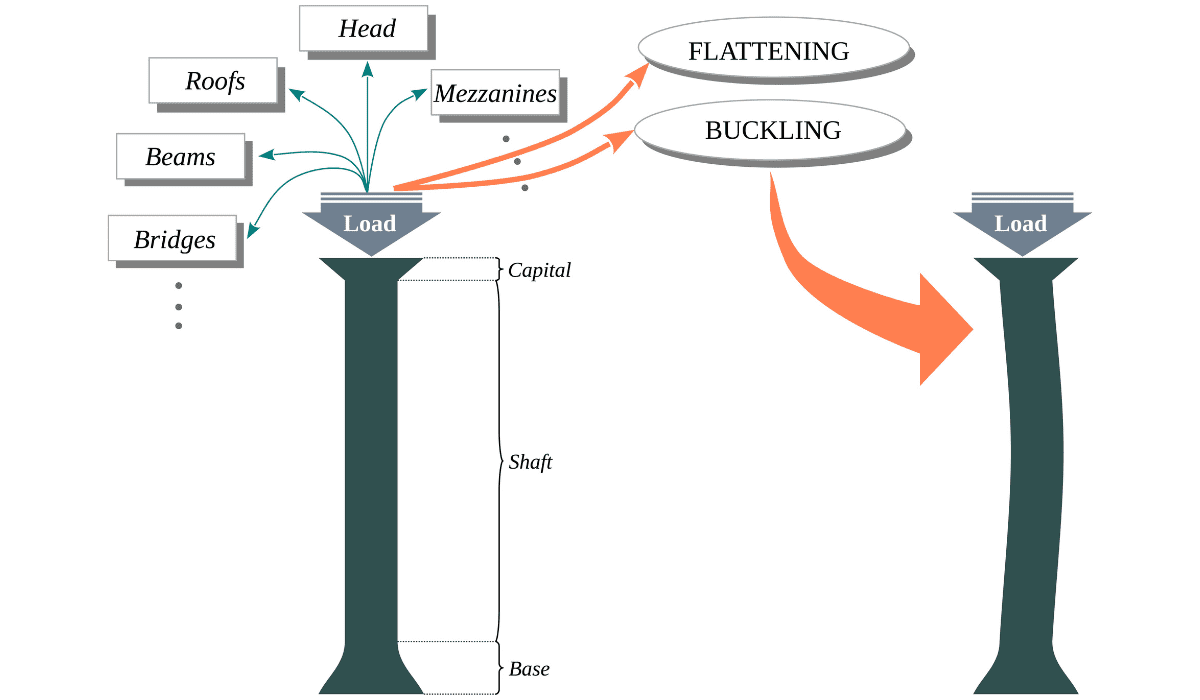There are several kinds of structural systems in use, but the framed structural system is the most prevalent nowadays. The foundation, column, beam, slab and other parts of this frame system are only a few examples. The components that span the whole height of the building as well as below the ground are known as structural columns. All of the load from the top floor of the structure is transferred to the bottom-most footing by the column, which plays a critical role in the load transfer process. Learn about the effective length of columns in this article.

Source: Pinterest
See also: Reinforced concrete column design
What is a column?
Every reinforced concrete construction needs to have a compression member or column. They are employed to securely transfer the weight of a superstructure to the base. In buildings, bridges, tanks’ support systems, factories, and many other structures of this type, columns, struts, and pedestals are mostly utilised as compression components.
A vertical compression part that is primarily exposed to effective length and axial loads that are greater than three times its smallest lateral dimension is referred to as a column. Pedestal is the name for the compression member whose effective length is less than three times its smallest lateral dimension.
Strut is the name for the compression part that is horizontal or inclined and is put under axial stresses. Trusses employ struts. The purpose of columns is to move the weight of the building vertically down to the base. The wall additionally serves the following purposes in addition to that:
(a) It creates seclusion and divides building spaces into distinct compartments.
(b) It offers protection from insects and break-ins.
(c) It keeps the structure warm in the coldest months of the year.
Column end conditions: What are they?
The circumstances at the column ends affect how much weight a column can support. In comparison to a second column of equal size, length, and material but with free ends on both ends, the column with set end conditions at both ends will be stronger.
Each column will have distinct carrying capacities. Knowing the column end conditions allows one to compute the effective length of a column. When column end circumstances vary, so does the effective length.
What are column effective lengths?
The distance between two consecutive places of contra flexure on the column is known as the equivalent or effective length. The location on the column where the direction of the column’s axis changes is known as the point of contra flexure.
By the idea of an effective length, the critical loads for columns with varied support conditions may be connected to the critical load of a pained-end column.
How to calculate effective length of a column?
The effective length of a column is the distance between its points of zero moment or the distance between the inflection points. It is an important parameter in the design of columns because it determines the critical buckling load of the column.
The effective length depends on various factors, such as the end conditions of the column, the type of loading, and the material properties. The following steps can be followed to calculate the effective length of a column:
- Identify the end conditions of the column: The end conditions of the column can be fixed, pinned, or free. These conditions are important in determining the effective length.
- Calculate the effective length factor: The effective length factor (K) is a dimensionless parameter that depends on the end conditions of the column. It can be found in design tables or calculated using formulas specific to the type of end conditions.
- Determine the unsupported length of the column: The unsupported length is the actual length of the column between the two points of zero moment. It can be calculated by subtracting the length of the fixed or pinned end connections from the overall length of the column.
- Multiply the effective length factor with the unsupported length: Multiply the effective length factor with the unsupported length of the column to get the effective length of the column.
Effective length = K x unsupported length
The effective length obtained in this way can then be used to calculate the critical buckling load of the column.
The bending stiffnesses of the beam meeting at the column, as well as whether the frame is swaying or not, determine the effective length of the column. Whereas a flexible beam will bend readily and not operate as a lateral restraint, a sufficiently stiff beam will not bend considerably when subjected to weights and will fix the column. The appropriate column length for each of the aforementioned scenarios is as follows:
| LENGTH OF COLUMN | ||
| No. | End-restrained of column | Effective Length (LE) |
| 01. | Securely maintained in place and restricted from rotating at both ends | 0.5 L |
| 02. | Effectively held in place at both ends, with rotation limited at one end | 0.7 L |
| 03. | Effectively kept in place but not constrained against at both ends | 1.0 L |
| 04. | Effectively held in place and restricted from rotation at one end, and restrained from rotation but not effectively held in position at the other end. | 2.0 L |
FAQs
What is the effective length of a column?
The effective length of a column is the distance between the points of zero moment or the inflection points of the column. It is used in the design of columns to determine the critical buckling load of the column.
How do I determine the effective length of a column?
The effective length of a column can be determined by identifying the end conditions of the column, calculating the effective length factor based on the end conditions, determining the unsupported length of the column, and then multiplying the effective length factor by the unsupported length of the column.
What are the end conditions of a column?
The end conditions of a column can be fixed, pinned, or free. These conditions are important in determining the effective length of the column.
Why is the effective length of a column important?
The effective length of a column is important because it determines the critical buckling load of the column. A column that is too long or too short for its effective length will not be able to support the required load, which can result in failure.
| Got any questions or point of view on our article? We would love to hear from you. Write to our Editor-in-Chief Jhumur Ghosh at [email protected] |
Housing News Desk is the news desk of leading online real estate portal, Housing.com. Housing News Desk focuses on a variety of topics such as real estate laws, taxes, current news, property trends, home loans, rentals, décor, green homes, home improvement, etc. The main objective of the news desk, is to cover the real estate sector from the perspective of providing information that is useful to the end-user.
Facebook: https://www.facebook.com/housing.com/
Twitter: https://twitter.com/Housing
Email: [email protected]












